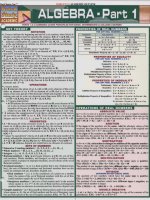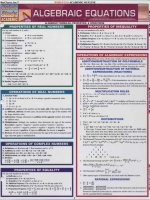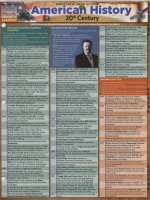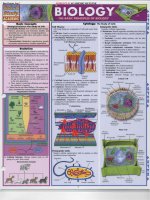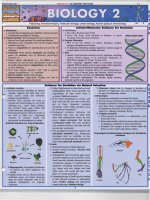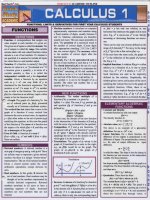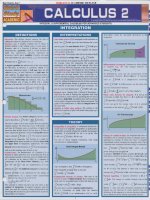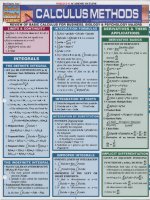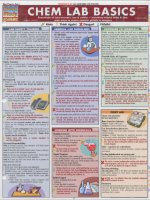Quick study academic circuit analysis 600dpi
Bạn đang xem bản rút gọn của tài liệu. Xem và tải ngay bản đầy đủ của tài liệu tại đây (12.8 MB, 6 trang )
WORLD'S #1 ACADEMIC OUTLINE
INTRODUCTION TO AC AND DC CIRCUIT ANALYSIS
Ideal Independent Sources
I. Its magnitude is measured in coulombs (C). The
charge carried by an electron is q.=-1.60xI o- 19 C.
A prolon has the same amount of charge, but with
positive polarity.
2. Charges are, therefore, of two types: positive and
negative.
3. Charges exist in discrete, integral multiples of ±q•.
4. Charges are conserved: They can be neither created
nor destroyed.
CURRENT. In an electric circuit, the charges move
along specified, closed paths. The motion of charges
constitutes an electric conduction current. Current is
measured in amperes (coulomb/sec). That is, one
ampere is the current that flows when one coulomb of
charge flows per second. Or, current i(t) in amperes is:
. ()
dq (I) amperes, were
h
.
t = ----at
q().
I IS t he charge In
I
coulombs, and I is the time in seconds.
- Conventions: A negative quantity of charge
traveling from B to A along a conductor is
equivalent to a positive quantity of charge going
from A to B. Hence, current is a vector.
- Unidirectional transfer of electric charge through a
conductor constitutes the direct electric current, or
dc. This is in contrast to ac (alternating current)
which implles a time-reversal of direction of current
such as a sinusoidal wave.
·VOLTAGE. Voltage difference (also known as
potential difference) between two points is
defined as the work [wet) in joules] required to
move a unit charge from one point to the other.
The unit of potential difference is the volt (V) .
Voltage (I') can be positive or negative .
dw (t)
Note that: v (t) = ~ volt
• POWER. Power pet) is the rate of doing work or the
rate of change of energy. The electrical unit of power
is the watt (W).
dw (t)
p (t) = ~ joule/sec or watts
.
Note:
V(t)l(t)
=
dw (t) dq
~ dt
=
dw ( t)
.
~ =p(t)
Thus, pet) = vet) i(t) is subject to the following sign
convention: Whellever th e reference direction fi)r the
current ill all elelllent is ill the direction ofthe voltage
drop across the element. use the forllluia p=vi. That
is, the current must enter the positive terminal to use
the above formula. Otherwise use p=- vi. If p(t»O ,
then the element absorbs power. If p(t)
-In Fig. ] (a) the element is
Fig.1
consuming/absorbing 18W of
power, and in Fig. I(b) the
3A
element is delivering 18W.
- FACT: The total power delivered -6V
must equal the total power
absorbed in any circuit.
• BRANCH. A branch is an
(a) Load
element (for example, resistor,
sources, etc.).
• NODE. A node is a junction
-6V
where two or more elements
come together.
_ f -3A
• GROUND. A ground is the voltage
reference point which has zero
(b) Source
potential.
• IDEAL INDEPENDENT VOLTAGE SOURCE.
This element maintains a
Fig. 2
specified voltage between its
terminals regardless of the
rest of the circuit where it is
inserted. The voltage is
'Cb
completely independent of the
Point a is Vs volts
higher than point b.
current through the element.
The symbol for the
Fig. 3
element is shown in Fig. 2.
OB
- Fig. 3 shows other
(a)
+
variations of Fig. 2:
V
Vs
- Fig. 3(a) shows an ideal
5b
battery which has a
constant voltage with
respect to time and (b)
(b)
shows
a
sinusoidal
Vmcoswt S
V(t)
voltage source which
swings up and down
-b
between the peak values
+v.. and -v..' producing an
Fig. 4
Vs ~B
:L »
.:r
Resistance & Conductance
• RESISTANCE. A resistor
Fig. 9
is a circuit element used to
model the resistance to the
flow of electrical charge.
V
R
V
R
The unit of resistance is the
ohm denoted by (D).
• CONDUCTANCE.
Resistor Symbols
Conductance (G) is defined
as the reciprocal of resistance; that is, G= I/R. Conductance
is measured in siemens (S) .
rl TI
rl
D
c[B
alternating current.
·fDEALINDEPENDENT
CURRENT SOURCE. This
element maintains a specified
current through it independent of
the voltage across it. See Fig. 4.
iS ~B
-
-
Ohm's Law
llJ
lJ
l
• OHM'S LAW (at a given
temperature) is given by
v=iR volt, and is based on
the following convention:
v=iR applies whenever the
reference direction for the
current in the resistor is in the direction of the voltage
drop across the resistor.
Otherwise use v=-iR.
Fig.
v
v = IR
to
R
V
R
+
V= - IR
Ohm's Law
~b --------------------~
Open & Short Circuit
C
is amperes flows
fro m b to a
Ideal Dependent Sources
• IDEAL DEPENDENT VOLTAGE SOURCE. In a
dependent (or controlled) voltage source, the voltage
across the source depends upon the voltage or current
across some other element in the network. There are
two types of controlled voltage sources:
- voltage controlled voltage source
v=avx where Vx is a voltage
somewhere else in the circuit
Fig.S
and a is a constant.
. - - - - - -O B
+
See Fig. 5.
- current controlled voltage
V
source
v=fJl" where ix is a current
b
somewhere else in the circuit
and fJ is a constant.
Fig. 6
See Fig. 6.
B
• IDEAL DEPENDENT
+
CURRENT SOURCE. In a
V
dependent (or controlled)
current source, the current
-b
through the source depends
upon the voltage or current
through another element in the
Fig. 7
network. There are two types
I
B
of controlled current sources:
+
- voltage controlled current
source
V"
i=rvx where Vx is a voltage
-b
somewhere else in the circuit
• OPEN CIRCUIT. The graphica l
representation of an "open circuit"
(R-+oo) is shown in Fig. II. Note
that the current can't flow due to
infinite resistance. The terminals
maintain an open circuit voltage.
• SHORT CIRCUIT. The graphical
representation of a "short circuit"
(R=O) is shown in Fig. 12. Note
that a short circuit can be considered
as a piece of wire assumed as a
perfect conductor (voltage = 0 ,
resistance = 0). Short circuit current
flows in the loop.
Fig. II
----l)t~..,.
+-----
v
,
m
-------0
;=0
R __ oo
Z
Open Circuit
~
Fig. 12
V=O
R=O
Short Circuit
Kirchhoff's Laws
• KIRCHHOFF'S VOLTAGE LAW
Fig. 13
(KVL): The algebraic SUlII of' all the
voltages around any closed path in a cilt'uit
equal, zero (at every instant o/'timej.
- Common Convention:
To avoid sign errors regarding KVL,
Kirchhoff's
use the voltage polarity sign of the
Voltage Law
element which you first encounter in
passing by that element. Example: If
Fig. 14
in Fig. 13 we choose to take the loop
clockwise, we hit the negative sign of
10A
the voltage source and the positive sign 12A
of VI ' Thus -v+vl=O.
• KIRCHHOFF'S CURI!ENT LAW
Kirchhoff's
,
(KCL): The algebraic sum o( all the
Current Law
currents at any node in a circuit equals
~
zero (at every instant o/'time).
- Common Convention:
Currents entering will be negative. Currents leaving will be
positive. (Opposite method is also permitted if you are ~
consistent.) Example: In Fig. 14, KCL for the node is
-12A+IOA+i2=0.
vy( { ,
1
r
~
and ris a constant.
See Fig. 7.
- current controlled current
source.
i=,ix where ix is a current
somewhere else in the circuit
and , is a constant.
See Fig. 8.
Fig. 8
I
+
B
~
C
Z
Series & Parallel Circuits
• RESISTORS IN SERIES: Two or more circuit elements
are said to be connected in series if they carry the same
current (and not merely equal currents). For any nwnber
of resistances in series add the values. Mathematically,
R,q= L Rn for n resistors connected in series.
n
- In Fig. 15: v=iR I+ iR 2+iR J = iReo
+0'
I
::
~
~~:_+D
;
i
R.
R3
R. q =R,+R2+ R 3
Resistors in Series
• RESISTORS IN PARALLEL: Elements are connected
in parallel if they have
Fig. 16
the same voltage
across them. In other + O-~----r-----'
words , elements are
connected in parallel
if
both
of the
terminals
of one
• NODAL ANALYSIS. A general procedure used to solve
any circuit of any size. The goal is to generate enough
equations to solve for a set of node voltages.
• CONCEPT: Given a system with N nodes, pick one as
the reference node. That is, J.Nu=O volt. Solve for the
other N - I node voltages.
• GENERAL PROCEDURE:
- N nodes. Pick one as reference. This leaves N-I
unknown node voltages. Thus we need N-I equations.
- Consider voltage sources. If the circuit has L voltage
sources, then represent each voltage source in terms of
its node voltages. This will yield L equations.
- (We now need N- I -L equations). Replace each
voltage source by a short circuit. This will result in a
circuit with (N-I-L) nodes (not including the
reference node). Write Kirchhoff's Current Law in
terms of node voltages at these (N-I-L) nodes
(referring back to the original circuit).
- Solve for the node voltages.
Note: For dependent sources, represent controlling
variable in terms of node voltages.
Example:
• FACTS:
- For resistors in parallel, the equivalent resistance Reo is
smaller than the smallest resistance of the parallel
combination.
- For resistors in series, R,q is larger than the largest of
the resistors.
- A short circuit in parallel with n resistors is equivalent
to a short circuit.
- An open circuit in series with n resistors is equivalent
to an open circuit.
- Voltage sources in series add algebraically.
- Current sources in parallel add algebraically.
Current Divider &
Voltage Divider
• CURRENT DIVIDER: Current division is used for
finding the currents through resistors connected in parallel.
Fig. 17
Current Divider
· 17'
iG m A mperes, were
h "IRM
- I n FIg.
, IRM = G
IS the current
'q
in one of the resistors R m, and Geq=GI+G2+···+Gn.
• VOLTAGE DIVIDER: Voltage division is used for
finding the voltages across resistors connected in series.
Fig. IS
R,
R2
Rn
t m~mmm:~mmJ
Voltage Divider
If n resistors are connected in series and a voltage source
v is applied across the combination, the voltage vm
.
across one of the resistors Rm
.
IS
vRm
Vm= LRn volts.
Fig. 21
20
40
Fig. 19
element are connected
Resistors in Parallel
to those of the other;
that is, if they share the same pair of nodes.
Mathematically, for n resistors connected in parallel.
- FACT: Conductances in parallel add.
Fig. 16 is a special case: For two resistors in parallel ,
RIR z
R,q= R I + R z and G,q= G I + G z
2. Open circuit current sources. If there are m current
sources, the new circuit has (L-III) loops.
3. How to pick loop currents:
a. Define loop currents for each loop obtained in step
2. i.e, 11.12 . ... / 1. - ...
b. Put each current source back in the circuit and
define a loop current that flows through the
current source. This yields III more loop
currents.
4. Each current source wi 11 yield onc equation, and
obtain the other L-nr equations by writing KVL
around loops obtained in step 2.
NOTE: By thi.~ method. each clIrrent sOllrce shollid
have only one ClIrrellt throllKh it.
EXERCISE
I. We have three unknown loop currents; thus, we need
three equations. Fig. 2 I.
2. After open-circuiting the current sources. the new
circuit will have only one loop. Fig. 22.
L
cbLJ
Fig. 22
I. Five nodes. One node is the reference node. Thus we
have four unknown node voltages: VI' V2• vJ. and v4'
2. The circuit has two voltage sources. Thus we obtain
two equations (equation numbers are in parenthesis):
(1)
Iv=vrvi
(2)
2V=V] - 1'2
3. After replacing each voltage source by a short circuit,
we have two nodes (not including the reference node):
°
10
4n
+
/,
- 6V
3. We now put current sources back into the circuit
and define loop currents 12 and ll' Fig. 23.
Fig. 23
20
Fig. 20
V,
12
i:~
- lA d)
20
V2
~r 02A
We then write KCL at nodes one and two:
(3)
i l +i2 =0
(4)
-i2 - I + i4 - 2 = 0 ~ i4 - i2 = 3
In order to represent these currents in terms of node
voltages, we need to look again at Fig. 19 from which
we can see that:
(5)
i , = (vl)(I)
(6)
i2 = (v4 - V2 )'J,
(7)
i4 = (I'J){'/4)
4. Now we solve for the node voltages by plugging
equations 5, 6, 7 into equations 3, 4:
(8)
VI + .5v4 - .5v2 = 0
(9)
----6A0
.25vJ - .5v4 + .5v2
=
3
Now by solving equations 1,2,8,9 we get:
VI = 1.286V, v2 = 4.857 V, v] = 6.857 V, V4 = 2.286V
• MESH ANALYSIS: This is an analysis technique
defined as follows:
- Loop. A closed path in a circuit.
- Mesh. A closed path that does not contain any other
closed paths within its boundaries.
- Loop current. A current that flows around a loop.
• OBJECTIVE: Write a set ofequarions in terms of these
loop currents, solve for the loop currents, and from these
find all the branch currents.
• GENERAL PROCEDURE:
1. Number of meshes equals the number of unknown
loop currents. For example, if we have L meshes, then
we have L loop currents.
2
3n
~.
4n
/,
4.12
=-
SA. 1.1 = 6..1
Mesh I: -6 + [II +12] 1.0+ 211 + [II +ll]4.o=0
Thus II =-"h
Source Transformations
• PRACTICAL VOLTAGE SOURCE: A practical (real)
voltage source is more accurately modeled as an ideal
voltage source in series with a finite internal source
resistance.
• PRACTICAL CURRENT SOURCE: A practical (real)
current source is more accurately modeled as an ideal ,urrent
source in parallel with a finite internal source resistance.
• FACT: A practical voltage source ean be transfurmed into
an equivalent practical current source. or vice versa.
Rs
Fig. 24
E ~ !: IT
Source T rans formation
Thevenin's Theorem
o
FACT: If a circuit is linear, then its v versus i curve must
be a straight line. Any linear circuit (Fig. 25a) can be
represented by its Thevenin equivalent circuit in the
following form (Fig. 25b) such that the two circuits are
equivalent, i.e., same v and i relationship.
-
FACT: For a circuit with two or more independent
sources we can find the response by considering each
independent source separately (others set to zero) and
adding the separate responses.
Fig. 25
r-_ _
...----,........:.....0 +
Linear
Circuit
Inductors •
-I~-O +
•
~ ~
rV
l.w·
before you can find R TH . Also, you must find the
short circuit current, i sc . That is, place a short circuit
across the terminals and calculate the resulting short
circuit current (in the direction of the open circuit voltage
drop across the noqes you want Thevenin's equivalent).
Use any method to find i sc , specifically source
transformations.
Fig. 27
2. The second way to
find RTH' is as
1=-1A
follows: "Kill" all
Linear Circuit +
th independent V = RTH
1A
the independent wi
sources rcmo\cd _
(not dependent)
(a)
sources in the
linear circuit. This
means independent
voltage
sources
1V
are shorted and
(b)
independent current
sources are opened.
Method 2 to find RTH
Place a one ampere
source (Fig. 27a) or a one volt source (Fig. 27b)
across the nodes you want Thevenin's equivalent and
voc
t).
Note: If all the sources are independent, then RTH is just
a series-parallel combination of the resistive network
left over when all the sources are turned off.
o THEOREM OF MAXIMUM POWER TRANSFER
Maximum power is transferred
Fig. 28
from a source network to a load if
the load resistance is equal to the
Thevenill equivalent resistance
R TH . In Fig. 28, RL =R TH is the
condition for vTH to deliver
maximum power to R L .
Maximum
o NORTON EQUIVALENT
Power Transfer
CIRCUIT:
The Norton equivalent circuit can be derived from the
Thevenin equivalent circuit by making a source
transformation.
Fig. 29
'se=
RTH
Leq =
L L., for n
o
CAPACITOR:
A two terminal device
Fig. 31
that consists of two + - -...- - - - .
conducting bodies that
~ i(t)
are separated by an
insulating material known
V(t)
C
as a dielectric. Because of
the dielectric, charges
cannot move from one
conducting body to the
Capacitor
other within the device.
They must therefore be transported between the
conducting bodies via external circuitry connected to
the terminals of the capacitor. The conducting bodies
are flat, rectangular conductors that are separated by
the dielectric material. The mathematical model of a
capacitor is shown in Fig. 31.
The model above is based on the following convention:
1
.( )
dv (t)
t = C~
I
applies
whenever
the
Norton Equivalent
number A is written in terms of its real and imaginary
definition A. In polar form, a complex number is
written in terms of its magnitude and angle. Therefore,
A = Ae jfJ = ALe where A is the magnitude. 6 is the
angle, e is the base of the natural logarithm, and as
before, j = A .
- The transition from rectangular to polar form makes
use of the geometry of the right triangle, namely
x
Ceq =
w=!-Cv 2
= (jx2+ y2)ejfJ= Ae jfJ where tane= Ix'
e=
tan-I~.
- Given a complex number A = ALa = Acosa +
jAsina. A*=AL-a
=
Acosa- jAsinais the complex
conjugate of A. To add or subtract complex numbers,
use the rectangular form; to multiply, divide, and raise to
a power, use the polar form.
Fig. 32
- It is not obvious in which I'm
quadrant the angle 6 lies.
The ambiguity can be
resolved by a graphical jy
i
representation
of the
complex number.
- Fig. 32 shows a complex
Re
number on the complex
plane; both polar and rectangular coordinates are shown.
• PHASORS. A phasor is a transformation that applies to
sinusoids. The definition ofthi, transfonnation is as follows:
Acos((I)t + 6) H Ae j9,
e.g., 2cos«(I)t + 10°) H 2e jlO'
4sin(3t) = 4cos(3t - 90") H 4e-j90"
- This transformation is very useful because it replaces
derivatives and integrals with algebra. Its limitations
are that it is only. useful in systems where the signals
are sinusoids, and the system must be in a steady-state.
The steady-state is a condition in which circuit values
remain essentially constant, occurring after all in itial
transients or fluctuating conditions have settled down.
This condition is valid if there is sinusoidal excitation
with only one frequency present.
reference
~C.
L C. for n capacitors connected in parallel.
+ jy
That is, A = (jx2+ y2),
direction for the current through the capacitor is in the
direction of the voltage drop across the capacitor.
dv (t)
Otherwise, use i (t) = - C ~.
FACTS:
- The unit of capacitance is the farad denoted by (F).
- The capacitor acts like an open circuit to a constant
voltage.
- Capacitors follow the same rule as conductances. That
(n.!.i).
1
components; hence A = x + jy where x is the real
component, y is the imaginary component, and j is by
~L.
2
/16.25 L tan -
/4.25 L tan - 1(-%5)' 20L-90. and 20LO expressed in
L,q= _1_1_ for n inductors connected in parallel.
- The energy stored in an inductor is given by
_ I Li2.
w-
/25 L tan - 1(y- 3 ) '
their polar form. In the rectangular form , a complex
inductors connected in series.
- The energy stored in a capacitor is given by:
Thevenin
numbers are
FACTS:
- The unit of inductance is the Henry denoted by (H).
- The inductor acts like a short circuit to a constant, or
dc, current.
- Inductors follow the same rule as resistors. That is.
is, C eq = _1-1- for n capacitors connected in series.
VTH
the operator j = IL90' or FT .
- Note that p = IL180" = -I. -j = IL-90' (and that
11= - j). The set of complex numbers is the set of all
points in the complex plane. Thus, complex numbers have
both a real and an imaginary component. -3+j4. 4+jO.5.
0.5-j2. 0-j20 and 20+jO are all examples of complex
numbers expressed in their rectangular form ; the same
direction for the current through the inductor is in the
direction of the voltage drop across the inductor.
di (t)
Otherwise, use v (t) = - L d t .
I. Use R TH = ~'c . That is, with this method, you must find
-
Capacitors
---J------.
EXERCISE
Objective: Given a linear circuit,
Fig. 26
find VTH and RTH of its equivalent
.--_....._
' =..:0
° +
using the methods below.
t
To find v TH : The Thevenin Linear
equivalent voltage, v TH ' is equal to
Circuit
the open circuit voltage voc ' Thus,
Method to
since vTH= voc> open circuit nodes
find VrH
across which you want Thevenin's
equivalent and calculate voltage using mesh, nodal, etc.
Two ways to find R TH :
COMPLEX NUMBERS. Real numbers such as -\. 3.5
and - j3 are oriented along the horizontal axis; thus.
they have an angle of either 180" or 0", and normally the
angle is omitted when the number is mentioned. The set
of imaginary numbers is located along the vertical axis,
in the complex plane. Thus, imaginary numbers have an
angle of either 90' or -90". This angle is indicated using
INDUCTOR: An inductor is a two terminal device that
consists of a coiled
Fig. 30
conducting wire wound
around
a core.
An +
i(t)
alternating current flowing
t
through the device produces
L
a magnetic flux ~ that V(t)
changes with time. This flux
then induces a voltage
V(t) = Ld/(t)
across the coil. The
cit
mathematical model of an
Inductor
inductor is shown in Fig. 30.
The model is based on the following convention:
di (t)
v (t) = L d t applies whenever the reference
Thevenin Equivalent
find the corresponding v or i ( RTH = vor R'm =
o
o
(b)
(a )
Sinusoidal
Sources • Phasors
o
FACT: Differentiation in the time domain corresponds
to multiplication by j(l) in the phasor domain. e.g ..
di (t)
- Considering v (t) = L dt' in phasor domain this
equation becomes
V=
Ljm/.
- Considering i (t)
= C d~~t),
equation becomes
7 = Cjmv.
in phasor domain thi s
- Considering v (t) = Ri (t), in phasor domain this
equation becomes V = RI.
Sinusoidal Power
• EFFECTIVE (RMS) VALUE. The effective value
of some time-varying voltage or current is that dc
voltage or current value which would dissipate the
same power in a resistor, R, as the time-varying
voltage or current would dissipate on the time
average in R. If itt) = Icos (ou), then the effective
value of the current would be leff =
/2..
+
T
leffis the effective value of the current, and 8 is the
angle
between phasor
=
~ff
and phasor
~ff
av,O' - a 1,0')' Given any physical system,
P (watt) is the only form of power that can be
converted from electric to heat, mechanical,
chemical or any other form (at the expense of some
loss). P is always positive.
• REACTIVE POWER. Given any circuit that
contains inductance and (or) capacitance, the
reactive power, Q (volt - ampere reactive -VAR), is
given by Q = V.ffleffsin8VAR. The reactive power
cannot be converted to any other form, but is
necessary for the conversion of real power. Q can be
either positive or negative.
• COMPLEX POWER. The complex power, (volt
ampere -~) is a complex number whose real part is P
(watt) and whose imaginary (reactive) part is Q(VAR).
Therefore, S(VA) = peW) + jQ(VAR) = V.ff~ff *.
• APPARENT POWER. The apparent power, S(VA),
is the magnitude of the complex power: S = V.ffleff'
• POWER FACTOR. The number cos 8=p/VI
represents the amount of watt that can be converted
in a system that requires so many volt-ampere; cos 8
is called the power factor; it is normally less than one
(less than 100%) and it can be lagging
leading
impedance of an inductor is given by ZL =jOJL; and,
the impedance of a capacitor is given by
I
Zc = jmC' Impedances follow the same laws as
Ipdt.
o
It can be shown that P reduces to P = V.ffleffcos8
watt, where V.ff is the effective value of the voltage,
(i.e.,a
element is defined as impedance, Z. Z is not a
phasor, but rather just a complex number. e.g. , the
-
• REAL POWER. The real power, P (watt), is the
average value of the product of instantaneous voltage
and instantaneous current. That is, if the instantaneous
power, p(l) is given by p(/) = v(t);(/) and T is the
period of the voltage, or current, waveform, then the
average power, P, is given by: P =
• IMPEDANCE. The ratio of phasor voltage across
an element divided by the phasor current through the
(I lags V)
or
(I leads V); since cos8= cost-B). the word
leading or lagging must be
specified after the value of the
Fig. 33
power-factor.
• THEOREM OF MAXIMUM
POWER TRANSFER
Looking at Fig. 33, for maximum
ZL
average power transfer to the load
must equal the
impedance,
conjugate of the_ Thevenin
impedance. That is, ZL = Z71l·'
However, a type of restriction occurs when the
magnitude of ~_ can be varied but its phase angle
cannot. Under this restriction, the greatest amount of
power is transferred to the load when the magnitude
of ~_ is set equal to the magnitude of Z71I .; that is,
resistors, e.g. , impedances in series add.
• ADMITTANCE. The admittance is the inverse
(reciprocal) 0/ impedance. Admittances follow the
same laws as conductances.
FACT: If the input to a linear system is sinusoidal,
then the output in steady state will be sinusoidal
with the same frequency, but different amplitude
and phase.
FACT: With the generalization of Ohm's law to time
varying situations, we can now apply voltage and
current division , loop and nodal analysis, and
Thevenin and Norton equivalent circuits to the
design and analysis of linear circuits in the
sinusoidal steady state.
IZII=IZTIII.
(a) "",",r Triangle for lagging
""'"" Factor (inductive Load)
(b) "",",rTriangle for leading
!'
• FIRST-ORDER CIRCUITS: A first order circuit
occurs whenever a circuit can be reduced to a
Thevenin or Norton equivalent connected to the
terminals of an equivalent inductor or capacitor.
Note that capacitors and inductors are not present in
a first order circuit. Furthermore, if more than one
inductor or capacitor exists in the circuit, they must
be interconnected so that they can be replaced by a
single equivalent element.
0 ) )2
W B .
- Concept: In electric circuits, switches are often
turned from on to off or vice-versa. It is therefore
ult on
necessary to analyze the pcrformance of the circuit
before and after the switch is open or closed. Usc 0
to denote the time just prior to switching and 0+ to
denote the time immediately following switching.
The circuit behavior before and after the switch is
operated, has a common link. If the switch is at
1=10' then the voltage across the capacitor at 1=/0
must equal the voltage across the capacitor at
(=(0+. Similarly, the inductor current cannot
change instantaneously.
Consider circuits that only have DC sources.
Fig.3S
- Observations:
For the circuit in Fig.
I. A capacitor is an open circuit to DC only in steady
35, find the output
state.
voltage ,:,",(t) when the
2. An inductor is a short circuit to DC only in steady
O.SH
input voltage vinet) =
state.
20cos (4001) V.
3. Steady state is defined as the condition when all
. Go to phasor domain.
the transients have died out. That is all the current
and voltages have reached a constant value.
jcr
vinet) = 20cos(4001) H 20e
= 20LO' = ~n
- Definition: Transient-time between two steady
By inspection, OJ =
states.
Fig. 36
rad
The scene: A switch is thrown at 1 = 10, Solve the circuit.
400 sec . Thus, Zz.
EXERCISE
= jOJL = j(400)(0.5).
The circuit becomes
as in Fig. 36.
J200n
~ut =
v
·200
100\ j200 =
IO
=
lO
cade
assuming the circuit contains one capacitor or one coil.
Step I: Analyze the circuit for t
/2 1. -
45 '
Step 2:Draw circuits for t>O. and represent as m
Fig. 39.
w
Fig. 39
3. Go back to time domain.
Vout(t)
OJ
nodal , inspection, etc. Remember, capacitors are
open circuits and coils are short circuits for DC
steady states. Whether it's asked for or not, find
v c( 0-) or IL(0- ).
2. Do the calculations
in phasor domain
since calculus becomes algebra.
/2 cos (400t - ~) V
vc(t)
Note: Since the input is sinusoidal, output will be
sinusoidal with the same frequency, but different
amplitude and phase.
Frequency Response
ZL
when
• POWER TRIANGLE
Response of First-Order
RL and RC Circuits
In the sinusoidal steady state,
the output (response) for a
sinusoidal input is also
"Sinusoidal with the same
frequency but with a different
amplitUde and phase.
Example (Fig. 37):
Excitation is vet)
Response is i(t)
Let vet) = 2cosOJt
Thus: j(t)=A(ro)cos(OJt + 9(OJ»
• Determi ning the frequency response of a circui t is
investigating the effect of varying the frequency of
the sinusoidal source. There are two primary reasons
for interest in the frequency response.
- First: Circuits that will transmit signals at some
frequencies noiiceably better than at other
frequencies can be used to filter out, or eliminate,
signals in an unwanted frequency range. The ability
to design circuits that are frequency-selective is
what makes radio, telephone and television
communication possible.
4
- Second: If the
frequency
response is known, then the
response of the circuit to any
other input can be predicted.
Convert Fig. 37 to the phasor
domain. See Fig. 38.
1 =V
-- =
l+jm
21.0'
)(1) 2+(m) 2 Lian -I m
Ill=~
It is possible to find i(t) for any ro.
. R e .~p{)ll~e
th
fi f'
. -H ( )
Defime the ratio
ExciUlti{)1I as e trans er unCtion . OJ.
FACTS:
I. H(OJ) is independent of the value of the input because
if you change the input (excitation) value. the output
changes correspondingly and the ratio stays the same.
h term
RL and RC Circuits cont.
2. Given H (t»), which is a function of the system,
we can find the output for any specific input.
Generalize: In a linear system the phasor voltages
and currents are linearly related, i.e., if X(t») is
the input to a system and Y(t») is the output, then
is linearly related to X(t») which leads to
our d
Y (t»)
There are 3 basic forms for v(t).
1. Overdamped
IL(t) = 8 + [20 - 8]exp-zsoo,
= 8
+ 12exp(-2500t)A
2
(Jc) > L~ two real negative distinct roots.
Ldl L(t)
VL(t) = -d-t
Solution is given as above: vet) =Ale'.' + Aze'"
2. Critically damped
= (8 x 10-3)(12)(-2500)exp-2500t
H( (i)) = ~((i)) = ~utput
X( (i) )
Find AI and A z from the initial conditions.
[h(O+) - h(oo)] exp ~t, t > 0
IL(t) = IL(oo) +
= -240exp( -2500t) V
Input
Find Thevenin equivalent across the capacitor or
the coil as in Fig. 40.
2
Fig. 49
Fig. 48
Idt)
Sketch
ofVdt)
S ............ ...
s.
t(sec)
v TH for vc(t) and
~: for
IL(t)]. Thus: ve(t) =
-(t-to))
v TH ( ve(tO-)-v TH ) exp [
le(t)
RTHC
't >0
dvc(t)
=C~,t>O
VTH + [I L(-)
VTH] up [-(t-tolRTH]
IL(t) = RTH
to - RTH
L
,t>O
dh(t)
vL(t) = L "'"(ft
Example:
The switch in the
circuit shown in
Fig. 41 has been
closed for' a long
time. At t=O, the
switch is opened.
Fig. 42 illustrates
the circuit for
1<0. Coil is a short circuit.
Vdt)
= 0, t
Fig. 42
v(t)
SmH
IL(O-) = 20A
Fig. 44
SU
Vdt)
,
= vc(O-)
[Recall that capacitive
voltages cannot change instantaneously.] As t-+ oo,
v(oo)= O. [energy has dissipated]
Question: How does ve(t) go from ve(O+) to O?
Solution: IR(t) + IL(t) + le(t)
~ +!
R
L
f'v (a) da
=
0, or
+ C dv(t)
dt
d 2v
ldv
RCdt
+
1
LC v = 0
1) = 0.
Voe ' Fig. 45.
Fig. 45
,..--..-___.1=0
,-0 +
12'1
r
SU
loc
;.
Voc = Veil = 160V
Therefore:
1,(0+) = 20A (initial value),
IL(oo) =
l'
1:
= 8A
= ~ = 8 X 10- 3
RTH
.4xI0-3sec
Thus,
~
20
= 2500/see
Fig. 46
~
~
RTH=12U+SU+20n
Fig. 47
S2+ J!c + L~ = 0
is the characteristic
equation.
The two roots of the characteristic equation are:
RC
(:J - L~
2
(--L)
IZ( (i) )1. does not have to be a maximum. although
at many times it is a maximum.
- Not all circuits have a finite nonzero resonant
frequency.
• HOW TO FIND THE RESONANT
FREQUENCY:
I. Set the imaginary part of Z( (i)) = 0 and solve for w.
OR
2. Set the phase = 0 and solve for t».
For the parallel RLC circuit:
Z((i))
=
I
G
+ j [(i)C - YwLJ
At resonant frequency,
(i)2 LC - I
(i)L
=
~
(i)C - ~L
0 OR (i) 2 LC
=0
OR
= I . ~ (i) = _1_
/LC
resonant frequency
b.
.; LC
Observation: If Z( (i)) is real . then Y((i)) is real.
• BANDWIDTH: Bandwidth (BW) is the range of
frequencies t»z - ())I where the magnitude of the
transfer function is within
())2
m
of its maximum
is called the upper cutoff frequency and
is called the lower cutoff frequency. For parallel
RLC, BW
=
ic'
• Q - QUALITY FACTOR.
Q ())) =21t' maximum energ~ stored in the system
(
energy lost In the system over
one cycle of the itlput signal
Denote Q( t») at t» = t»o as Qo' For the parallel RLC
= (i)Q 0 .
o
Assume v(t) in Fig. 51 is sinusoidal. Then the circuit
goes to the phasor domain as in Fig, 52.
circuit, Qo = ())oRe. Note that BW
2
=l±
- At resonant frequency, the magnitude of Z( (i)),
())I
Cannot use A = 0 as a general solution, because to do
so implies that the voltage is zero for all time - a
physical impossibility if energy is stored in either the
inductor or capacitor.
Thus:
phase of Z( (i)) is O.
value.
S
A e st( s 2 + RC
+ LC
R TH : Kill independent sources. Fig. 46.
- At resonant frequency, Z( (i)) is real. Thus the
For parallel RLC. (i)o=
Assume a solution of the form: v = Ae", where A and
s are unknown constants. By substitution,
SmH
• RESONANT FREQUENCY: The frequency at
which the input impedance is purely real.
- Resonant frequency is not defined in terms of the
transfer function. For the parallel RLC circuit, the
transfer function equals the input impedance.
Notation: %
= 0
Differentiate both sides with respect to t and divide
through by capacitance C.
d(2 +
lo(t) 12U
dv(t)
= C~ and
f v (a) da
At t=O+, veCO+)
For t>O, Fig. 43.
Need to find the Thevenin equivalent across the coil.
Fig. 44.
= 20A
to
IL(t) = ILco+) +
=
Fig. 43
R' Ic( t)
= A.e'.' + Aze"'.
Resonance
Goal: Need v(t) for t>O . From v(t) it is possible
to find:
C
EEJ'" 8 10(0
IdO+) = 'L(O,
The solution is vet)
Finding the natural response of a parallel RLC circuit
consists of finding
Fig. 50
the voltage created
across the parallel
branches by the
release of energy
R L
V
that has been stored
in the inductor or
capacitor, or both.
The task is defined in terms of the following circuit
t~O as in Fig. 50.
Assume the circuit has stored energy in the form
IL(O-) =IL(O+) and vcCO-) = vcCO+).
IRCt) =
s. =sz'
and Sz are complex conjugates of each other.
Natural Response of
Parallel RLC Circuits
3. Write down the answer.
[Note that the final value (steady state solution) is
[s" Sz real and equal]
2
(Jc) < L~
t(sec)
-240
sl = Sz
Solution changes to vet) =A.e'" + Azte'.'
3. Underdamped
VL(t)
Sketch
ofldt)
20
(2jC) = 2c
therefore
2
-..!.. and
2RC
S2= 2;~ - (~C) - :C
If these two solutions are denoted as
R
VI
respectively, then their sum is also a solution.
v = VI + V z = Ale'" + Aze s" is a solution.
5
and
V
z
fJ
Fig. 52
Fig. 51
LC
2
l
R
+
L
-
V
jwL
Resonance - cont. fiv lII page 5
~
• QUESTION: Find (a) the bandwidth BW, (b) resonant
frequency 000 , and (c)Q.
ll(w)=~.
(a)For BW, need
For this example,
I
Fig. 57, shows a more practical model of the coil
because it accounts for the losses in the inductor,
represented by the resistor R.
Recall Q(coil) = Qp = 230.
Q.
=
~
From the sketch in
Fig. 53, 00 1=0,
and 00 2= Y .Thus,
W('Bd)
R
=
reduces to the values shown in Fig. 59.
B6C
R
T
BW=~-~=r'
(b) There is no finite non-zero resonant frequency since
Yin(W)
(c Q (w)
)
=
R + ~WL will be real only when 00=0.
(
---t
...tIIIII
Thus, Q = 2n: 11
12 Rl.,T =
"I11III
Z Substitute T = :
2
=>
Q (w)
2n:L
RT
= ~L
•
Consider the following two circuits:
D.
Z(s) = Rs + jXs
=
~
Y(p)
FACT: Q,= I!,I
'
y(t)=AIH(jW)lcos[oot + fJ+ 8(00») (for steady state).
Fig. 54
Definition: The amplitude of ll(jw) in decibels is
l
= Gp + --=-x
)
FACT: Qp =
Adb= 20Iog lO
l~pl
p
Objective: Find output and amplitude of H(jw) in
decibels. _ .
w = 2 => H( 2))
Qo(system) = 50
6 X 10
= ----so
= 1.2 x
6
=
ic
Z
k
it
iour(t)
=
2
Jz
~.
looks like Fig. 62
I)m looks like Fig. 63
(1+ )WB
. ..fQ..
slope
~
-20 • m dB/decade
Fig. 63
Also, Bode plot of constant Ao is
slope =\ -20 • m dB/decade
20logAo as shown in Fig. 64
dB
Note: Application of this Bode
approximation - for a more
approximation
plot
~.
of
ll(jw) .
~a.mple:
(jw + 10 P
H()W) = (jw+W(jW+lOO)
( I+'W/ )
J /WB'
'w/jJ
[
1000 1+) /10
For ll(jw)
cos (2t - 45 ').
=
2 +2jW' 1H(jw) 1 =
that C;:I.4x 10- loF.
+ 2010g ll+ j o/tool-1
db = 20log 1H(jw) 1
=2010g~
4+
=
~91r~jlJll~~II~I!rJI~JIJ211f1ll l! Ilil~I
= 20logl0 + 60log II
ill
2)-112 )
- 2010gl'
.
=
l
Ao
I+(~B)
2]
+ j%)()1
Now each function is in standard form. Sketch each term
and add as shown in Fig. 65. Begin with 20dB straighl
line. -40dBldec slope takes us to -20dB at 00=10. The
60dBIdec slope adds to the -40dB/dec slope giving
20dBIdec slope. This 20dBIdec slope takes us from -20dB
at 00=10 to OdB at 00= 100. At 00= 100. the -20dB/dec
slope adds to the 20dBIdec slope. keeping US at OdB.
1/2
Fig. 65
dB
Note 10 Student : Dut! to its coodem;6(l format. I.!Soe thiS Guolck,turdy· guide as an outline ol!ha
basics 01 Clrcuil Analysis but not as a replacement tor asSigned cours& work.
All ril!hts fl:SC'f\"cd. N(. pan of 1ius publication may be reproduced or lransmi ned in an~ foon. (Ir hy any
~ans. ele<:tronoc or mechanic;; l. 'l"IC h..:lmg pholocopy. t"eC{lrdmg. Dr an y informauon SI()I"1Iie.nd rt'lne, .. 1
~ySlem. wilhoul wrillcn penms,iOfl from lhe publi~het.
«;\1999, 2004 Barcharts. In<::. Boca Ratoo. FL. 0308
free downloads &
.n u" dredsIlf ttlres at
qUlcKsluay.com
Customer Hotline # 1 8002309522
We welcome your feedback so we can
mamtam and exceed your expectations
+ jW;{ol- 40log II + jwl
w
1+)wB
It follows IH(jW)1
~ ~------------------~
ISBN-13: 978-157222521-3
= 20loglO + 20 log II + jo/tol·1 + 20 log II + jwl- 2
= 20 log 2 + 201og(4 + 00 2)-1/2
= 20 log 2 -IOlog(4 + 00 2).
Ao
Take H(jw)
w .
Fig. 56
D. U.S.$5.95 CAN.$8.95
~
and 8Uoo) = -tan-I~
= 20 log ( 2 ( 4 +
Thus the values in
Fig. 55 change to that
shown in Fig. 56.
=
and 8(2j) =_45'.
5
10 rad/sec
follows that R=60kD.
~
Fig. 62
First we need to put terms in the form.
= I +j
+2
- 20dBIdecade
Steady state response is given by:
Note: Manufacturers of coils
intended for frequency-selective
circuits specify the Q of the coil at specific frequencies. The
coil Q and the system Q are not the same. To find a coil that
works at/o=106 Hz use a specification sheet. Assume we
find Q(coil)=230 and the corresponding L =200JJll.
EXERCISE
Find a parallel RLC circuit to meet these specs.
BW
j2
Jz
=
I
2
=
~
dB
involved H(jw), we can obtain a
Given: i(t)= 2cos2t = input, ll(jw) = jw~ 2
Thus, IH(2j)1
It follows from ClIo=
r
1
1+ . ..fQ..
quick
EXERCISE
.'./0= 10 6 Hz
From
lll(jw)l·
p
Example: See Fig. 55
Specifications:
OOo=6XI06 rad/sec
BW
slope
It follows that the Bode plot of
FACT: The transfer function relates the steady-state
response to the excitation source. That is, for
sinusoidal input x(t) = Acos(oot + fJ) the output
III Generalization: First l(OO) = R + jX(oo)
--tr.
)WB
Bode Plot
~ Ll;
=-40
The sketch is as in Fig. 61:
Generalization: Bode plot of
TRl2
RI2T
-y-[I + cos 2 oot)dt =
a
w
-20 log w B = 0
wR
Energy lost/cycle computes as:
f Rlmcos2wtdt = f
OOB'
For 00= 100Wn, -20 log w
P R(t)= P(t )R=Rl., 2COS 2oot
a
Fig. 61
dB
W
00 occurs when cos 2oot=1. Therefore, w.,ax(t)=t/2Llm2.
2
--IOIOg(~Br
For 00 = I0Wn, -20 log w B = -20
w(t)= I/zLi2(t)=t/zLl.,2COS 2oot. Thus maximum value of
(~Br - (~Br
ForOO
For 00 =
energy lost/cycle
+( ~Br).
This approximation can be used to sketch the result on
semilog paper. Back to the example:
ForOO
= -20 log ..fQ..
WB
= 2n: [max imum energy stored].
..
The actual sketch resembles that shown in Fig. 60.
Note: For bode plots an approximation is made:
For 00> Wn, dB
Let i(t)=l.,cosoot. Then energy stored in an inductor,
T
~k
-10 log (1 +(:B) 2)
Let Ao = I. Then it follows: dB = -IOIOg( I
357kD. Now obtain better model, as in Fig. 58,
R
Fig. 60
We sketch ll(jw) in dB versus 00.
it follows that
Rp = QpOOLp;: 276D.
Now repeat for the capacitor.
Rp
Rp
Qp
Qp= -I-I = 11
= RpWCp. Thus, Rp= wC
Xp
/ WCp
p
Fig. 53
IH(w)1
Ao 2 11/2 1=
1+ ( .!!L )
roB
20logAo
.
Rp
Rp
Smce QP=-I-1= wL '
Xp
p
~
In db, db = 2010g [[
20 log IH(jc·,)1
40
20
-20
61,.1,.11" 6
6
-40
/
..""
dB
....
60 d-ecs1ope
/~
... :: :::::: ::.~.~I
2010g10
/
1000
oo(Iog)
20~
dec
